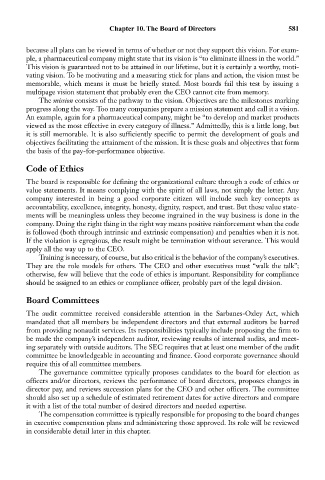Page 595 - Bruce Ellig - The Complete Guide to Executive Compensation (2007)
P. 595
Chapter 10. The Board of Directors 581
because all plans can be viewed in terms of whether or not they support this vision. For exam-
ple, a pharmaceutical company might state that its vision is “to eliminate illness in the world.”
This vision is guaranteed not to be attained in our lifetime, but it is certainly a worthy, moti-
vating vision. To be motivating and a measuring stick for plans and action, the vision must be
memorable, which means it must be briefly stated. Most boards fail this test by issuing a
multipage vision statement that probably even the CEO cannot cite from memory.
The mission consists of the pathway to the vision. Objectives are the milestones marking
progress along the way. Too many companies prepare a mission statement and call it a vision.
An example, again for a pharmaceutical company, might be “to develop and market products
viewed as the most effective in every category of illness.” Admittedly, this is a little long, but
it is still memorable. It is also sufficiently specific to permit the development of goals and
objectives facilitating the attainment of the mission. It is these goals and objectives that form
the basis of the pay-for-performance objective.
Code of Ethics
The board is responsible for defining the organizational culture through a code of ethics or
value statements. It means complying with the spirit of all laws, not simply the letter. Any
company interested in being a good corporate citizen will include such key concepts as
accountability, excellence, integrity, honesty, dignity, respect, and trust. But these value state-
ments will be meaningless unless they become ingrained in the way business is done in the
company. Doing the right thing in the right way means positive reinforcement when the code
is followed (both through intrinsic and extrinsic compensation) and penalties when it is not.
If the violation is egregious, the result might be termination without severance. This would
apply all the way up to the CEO.
Training is necessary, of course, but also critical is the behavior of the company’s executives.
They are the role models for others. The CEO and other executives must “walk the talk”;
otherwise, few will believe that the code of ethics is important. Responsibility for compliance
should be assigned to an ethics or compliance officer, probably part of the legal division.
Board Committees
The audit committee received considerable attention in the Sarbanes-Oxley Act, which
mandated that all members be independent directors and that external auditors be barred
from providing nonaudit services. Its responsibilities typically include proposing the firm to
be made the company’s independent auditor, reviewing results of internal audits, and meet-
ing separately with outside auditors. The SEC requires that at least one member of the audit
committee be knowledgeable in accounting and finance. Good corporate governance should
require this of all committee members.
The governance committee typically proposes candidates to the board for election as
officers and/or directors, reviews the performance of board directors, proposes changes in
director pay, and reviews succession plans for the CEO and other officers. The committee
should also set up a schedule of estimated retirement dates for active directors and compare
it with a list of the total number of desired directors and needed expertise.
The compensation committee is typically responsible for proposing to the board changes
in executive compensation plans and administering those approved. Its role will be reviewed
in considerable detail later in this chapter.

